Introduction
Habitual buying, a fascinating aspect of consumer behavior, revolves around the repetitive purchasing habits individuals develop over time. It is a phenomenon deeply ingrained in our daily lives, where certain products or brands become an automatic choice due to familiarity, convenience, and emotional attachment. Understanding the psychology behind habitual buying is crucial for marketers to design effective strategies that tap into this behavior and create lasting customer loyalty.
At its core, habitual buying is when individuals engage in repeated purchasing behavior without much conscious thought or consideration. It is driven by the power of routine and automation, where certain products become an integral part of our everyday lives. For instance, imagine the morning routine of a coffee enthusiast who cannot start their day without a hot cup of their preferred brand. This habitual buying behavior is deeply rooted in their daily routine, and they automatically reach for that particular coffee brand without actively considering alternatives.
A classic example of habitual buying can be seen with the success of tech giant Apple. Once individuals become accustomed to the user-friendly interface, sleek designs, and seamless integration of Apple products into their lives, they often develop a strong attachment and loyalty to the brand. This emotional connection, combined with the ease and convenience of using Apple products, keeps customers continuously coming back for more, even when there may be other options available in the market. Habitual buying becomes a part of their identity, reflecting their lifestyle and values.
Factors Influencing Habitual Buying
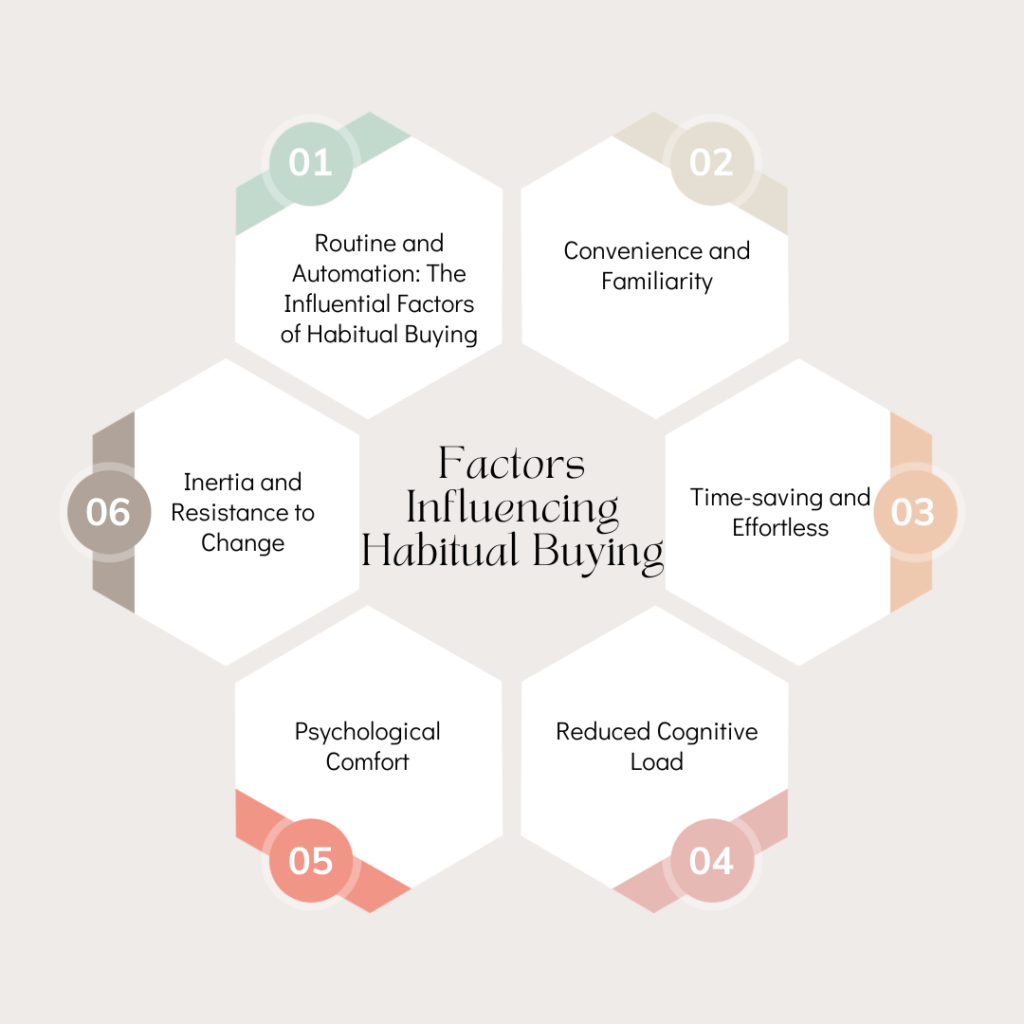
Routine and Automation: The Influential Factors of Habitual Buying
In today’s fast-paced world, routine and automation play a significant role in shaping consumer behavior, particularly when it comes to habitual buying. Let’s delve deeper into the factors that contribute to habitual buying within the context of routine and automation:
Convenience and Familiarity
One of the primary reasons for habitual buying is the convenience and familiarity associated with certain products or brands. When individuals establish a routine of purchasing a specific item, it becomes ingrained in their daily lives. For example, buying a certain brand of toothpaste or a preferred brand of coffee becomes an automatic decision due to its familiarity and ease of acquisition.
Time-saving and Effortless
Habitual buying provides consumers with a sense of time-saving and effortlessness. When a particular product has consistently met their needs in the past, individuals find it more efficient to continue purchasing it without considering alternatives. This aspect is especially prevalent for frequently consumed products or everyday necessities, such as groceries or personal care items.
Reduced Cognitive Load
Making decisions requires cognitive effort, and habitual buying helps reduce this load. Once a routine is established, consumers no longer need to actively evaluate different options, compare prices, or research alternatives. They rely on their ingrained habits, allowing them to make quick and effortless purchasing decisions.
Psychological Comfort
Habitual buying can also provide individuals with a psychological sense of comfort and security. When people stick to what they know and trust, they feel reassured that their needs will be consistently met. This emotional attachment to familiar products or brands can act as a driving force for habitual buying behavior.
Inertia and Resistance to Change
Changing one’s habitual buying behavior can be challenging due to the concept of inertia. Once a habit is formed, individuals may experience resistance or discomfort when attempting to switch to a different product or brand. This resistance often stems from the fear of the unknown, potential dissatisfaction, or the inconvenience associated with trying something new.
The Psychological Aspect of Habitual Buying
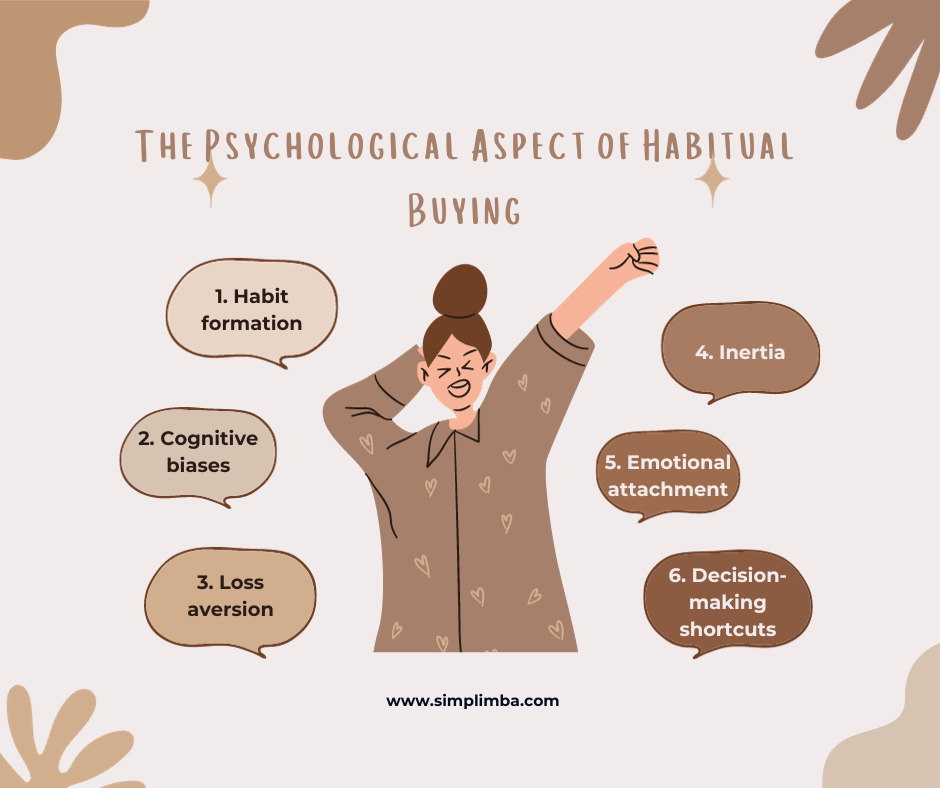
1. Habit formation: Habits are deeply ingrained behaviors that become automatic responses to specific cues or triggers. They are formed through a process called habituation, where repeated actions or routines create neural pathways in the brain that make the behavior more automatic and less conscious. Marketers can leverage this natural tendency towards habit formation to encourage repeated usage of their products.
2. Cognitive biases: Habitual buying is also influenced by various cognitive biases. One such bias is the mere exposure effect, which suggests that people tend to develop a preference for something simply because they are familiar with it. This bias is often exploited by marketers through consistent brand exposure, thereby increasing the likelihood of habitual buying.
3. Loss aversion: Once a habit is formed, individuals may experience discomfort or resistance when trying to change their purchasing behavior. This is due to loss aversion, a psychological phenomenon where people are more motivated to avoid losses than to acquire equivalent gains. As a result, individuals are more likely to stick to their habitual buying patterns rather than explore new options.
4. Inertia: Habitual buying is often characterized by inertia, where individuals continue to buy products out of habit rather than actively considering alternatives. This is because habitual buying requires minimal cognitive effort as individuals rely on their automatic responses. Marketers can capitalize on this inertia by making their products easily accessible and convenient to purchase.
5. Emotional attachment: Emotional attachment plays a significant role in habitual buying. Consumers may develop a strong emotional bond with a particular brand or product, which reinforces their tendency to make repeated purchases. This emotional attachment can be cultivated through effective branding, storytelling, and creating positive experiences that resonate with consumers on a deeper level.
6. Decision-making shortcuts: Habitual buying is also influenced by heuristics, which are cognitive shortcuts or rules of thumb that individuals use to make decisions quickly and efficiently. For example, individuals may rely on the availability heuristic, where they base their decision on how easily they can recall instances of purchasing a particular product in the past. Marketers can leverage these decision-making shortcuts by ensuring their brand is easily recognizable and associated with positive experiences.
Effects of Habitual Buying
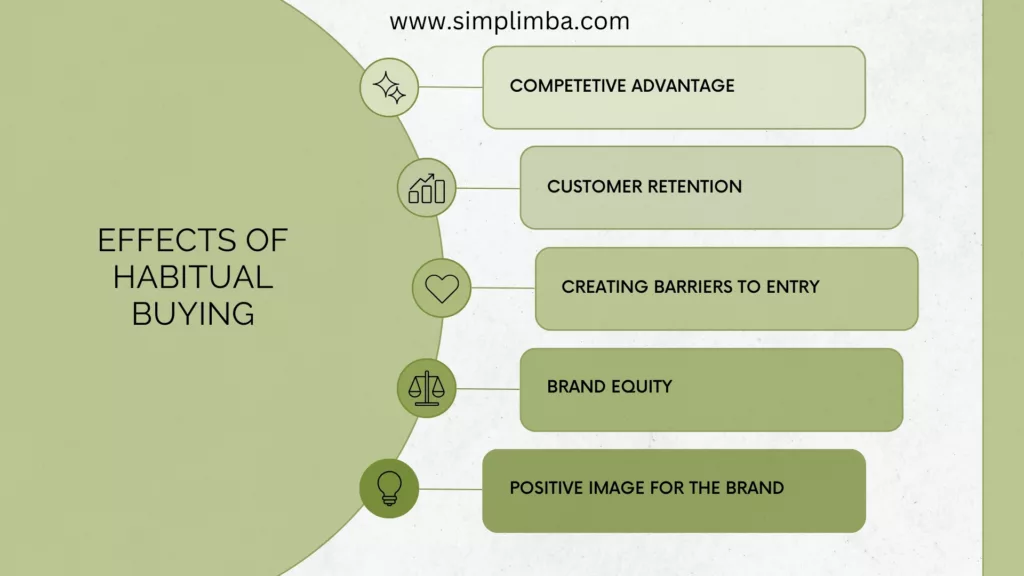
1. Customer Retention
Habitual buying plays a vital role in customer retention. When consumers develop a habit of purchasing a particular product or brand, they are more likely to continue purchasing it over time. The familiarity and convenience associated with habitual buying reduce the effort required for decision-making, leading to increased customer loyalty.
Effective customer retention through habitual buying provides several benefits to businesses:
– Increased customer lifetime value: By consistently meeting the needs of habitual buyers, businesses can generate a steady stream of revenue from loyal customers. This extends the customer relationship, increases the average purchase frequency, and enhances the overall value of the customer over time.
– Cost savings: Acquiring new customers can be more expensive than retaining existing ones. Habitual buying reduces the need for continuous marketing efforts aimed at acquiring new customers, thus saving costs associated with customer acquisition.
– Word-of-mouth marketing: Habitual buyers who are satisfied with a product or brand are more likely to recommend it to others, contributing to positive word-of-mouth marketing. This can lead to an influx of new customers and further reinforce customer retention.
2. Competitive Advantage
Habitual buying can confer a significant competitive advantage on businesses. Once customers develop a habit of buying a specific brand or product, they become less likely to switch to alternatives, even when presented with competitive offers. This advantage can manifest in various ways:
– Market share dominance: Brands that successfully establish themselves as habitual choices in the minds of consumers can capture a substantial share of the market, making it difficult for competitors to gain traction.
– Pricing power: The loyal customer base built through habitual buying allows businesses to have more flexibility in pricing. Customers who have developed a habit of purchasing a particular brand are often willing to pay a premium price, reducing the price sensitivity of these buyers.
– Protection against price wars: Habitual buying mitigates the impact of price wars in the marketplace. When consumers are loyal to a particular brand, they are less affected by price fluctuations and less likely to switch to cheaper alternatives, thus shielding businesses from intense price competition.
3. Barriers to Entry
Habitual buying creates barriers to entry for new entrants in the market. When consumers have strong habits associated with a specific brand or product, they are less likely to experiment with unfamiliar alternatives. This poses challenges for new entrants looking to establish their presence and gain market share.
– Consumer resistance to change: Habitual buying triggers a sense of attachment and loyalty among consumers. Breaking these habits and convincing consumers to switch to a new brand requires significant effort and resources. The resistance to change acts as a barrier for new entrants, making it harder for them to win over customers from established players.
– Brand recognition and trust: Habitual buying is often a result of a long-standing relationship between consumers and a particular brand. Established brands enjoy higher levels of recognition, credibility, and consumer trust, which further reinforce habitual buying behavior and create obstacles for new players.
4. Brand Equity
Habitual buying has a profound impact on a brand’s equity. Brand equity encompasses the value and perception associated with a brand in the minds of consumers. Habitual buying contributes to the development and strengthening of brand equity in several ways:
– Emotional connection: Habitual buying can foster emotional connections between consumers and a brand. Emotional attachment leads to increased brand loyalty, positive brand associations, and a willingness to advocate for the brand.
– Perceived quality and reliability: Habitual buying reflects consumer confidence in the consistent quality and reliability of the product or brand. The repetition of purchases builds the perception that the brand consistently delivers on its promises, further enhancing brand equity.
– Positive brand image: The consistent purchasing behavior associated with habitual buying creates positive brand image and visibility. As more consumers engage in habitual buying, the brand gains prominence and recognition in the marketplace.
– Premium pricing: Habitual buying enables brands to command premium prices based on the trust and loyalty established with consumers. Consumers who habitually buy a brand are often willing to pay a higher price, perceiving the brand to be of higher value than its competitors.
Strategies for Marketers to boost Habitual Buying
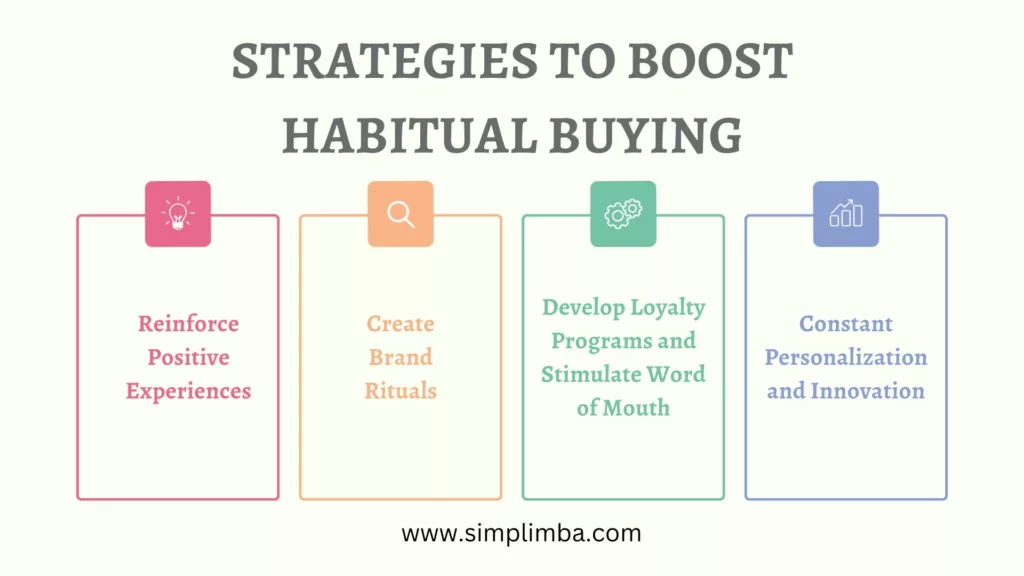
Reinforce positive experiences
– Providing exceptional customer service: Prompt and helpful assistance creates a positive experience, increasing customer satisfaction and the likelihood of habitual buying.
– Consistent quality: Ensuring the product or service consistently meets or exceeds customer expectations builds trust and reinforces habitual buying behavior.
– Creating memorable experiences: Going above and beyond to create memorable experiences through personalized interactions or surprise elements can leave a lasting impression, strengthening the emotional attachment to the brand.
Create brand rituals
– Developing rituals or routines associated with the product: Marketers can encourage habitual buying by integrating the brand into consumers’ daily routines. For example, a coffee brand can associate itself with the morning ritual of brewing coffee, creating a strong habitual connection.
– Utilizing sensory cues: Associating the brand with specific sounds, scents, visuals, or taste can trigger an automatic response from consumers, reinforcing habitual buying behavior.
Loyalty programs
– Rewarding loyal customers: Implementing loyalty programs that offer exclusive benefits, discounts, or personalized offers to repeat customers can enhance their sense of appreciation and strengthen their attachment to the brand.
– Personalized recommendations: Utilizing customer data to provide personalized recommendations or suggestions tailored to individual preferences can increase the chances of habitual buying.
Stimulate word-of-mouth
– Encourage satisfied customers to share their experiences: Leveraging the power of word-of-mouth marketing, marketers can encourage satisfied customers to share their positive experiences and recommendations with their social networks. This can significantly amplify the effects of habitual buying, as recommendations from trusted sources carry more weight.
– Utilize social media influencers: Collaborating with social media influencers or brand ambassadors who align with the brand values and target audience can help generate buzz, increase brand visibility, and drive habitual buying behavior.
Seamless and convenient purchasing experience
– Streamline the purchasing process: Simplifying the buying process, offering multiple payment options, and ensuring a user-friendly interface on both online and offline platforms can remove barriers and encourage habitual buying.
– Subscription models: Offering subscription-based services or products can create a sense of convenience and automates repeat purchases, making it easier for customers to maintain their habitual buying behavior.
– Predictive analytics: Utilizing customer data and predictive analytics to anticipate customer needs and proactively offer relevant products or services enhances convenience and reinforces habitual buying.
Continuous innovation and personalization
– Regularly updating products or services: By introducing new features, flavors, or variations, marketers can keep customers engaged and prevent habit boredom, ensuring long-term habitual buying.
– Personalization based on customer preferences: Leveraging customer data, marketers can personalize product offerings, recommendations, and messaging, creating a sense of exclusivity and fostering habitual buying.
Building trust and credibility
– Transparent communication: Openly sharing information about the brand, its values, ethics, and sourcing can build trust and credibility, enhancing habitual buying behavior.
– Social responsibility: Engaging in socially responsible initiatives or sustainability efforts can resonate with conscious consumers and reinforce their commitment to the brand, leading to habitual buying.
Implications for Marketers
Understanding the influence of routine and automation on habitual buying behavior can be invaluable for marketers. Here are a few strategies to consider:
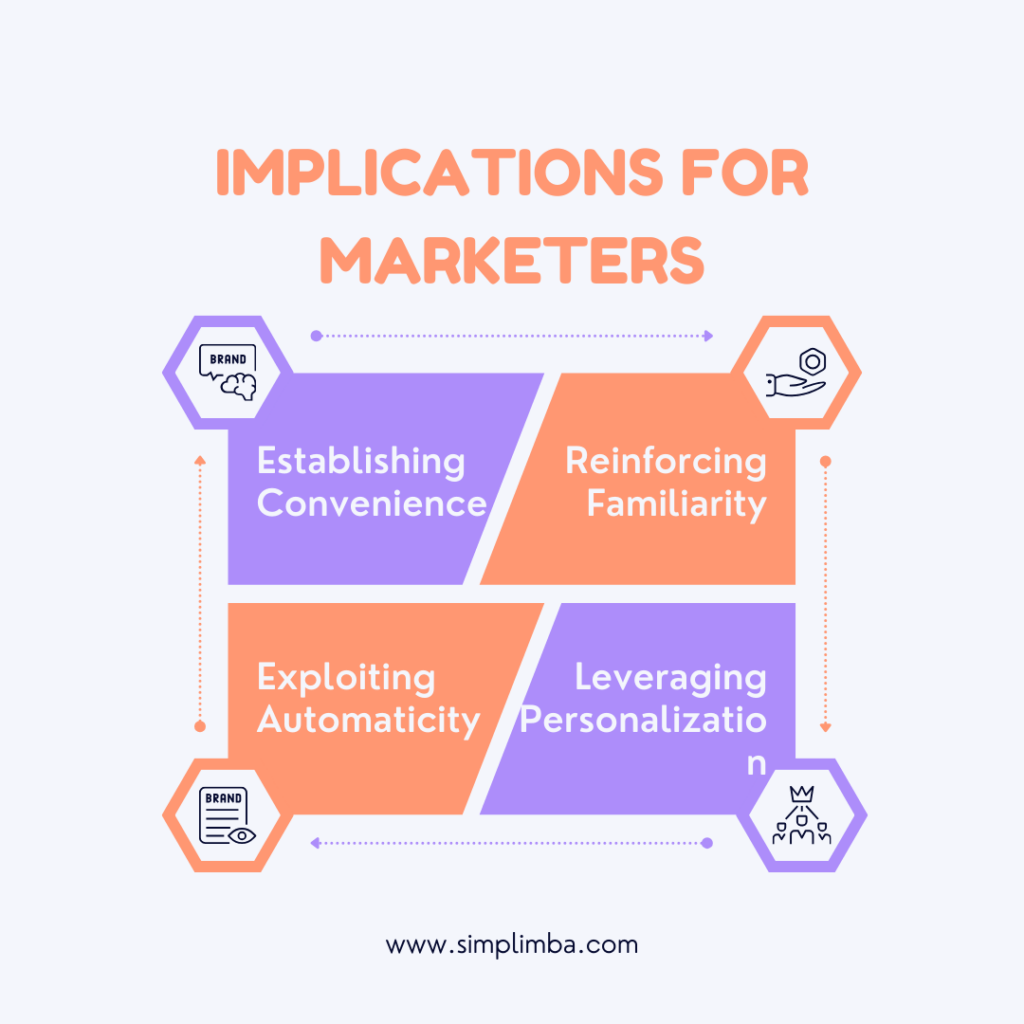
Establishing Convenience: Make sure your product or brand is readily available and easily accessible to consumers. This could involve optimizing distribution channels, offering online purchasing options, or partnering with retailers who align with your target audience’s routines.
Reinforcing Familiarity: Build brand loyalty by consistently delivering a positive experience and maintaining product quality. Through effective marketing and communication strategies, emphasize the benefits and reliability of your product, creating a sense of familiarity and trust in your target audience.
Exploiting Automaticity: Identify opportunities to position your product as a “go-to” or default choice within consumers’ routines. By aligning your product with existing habits, you increase the likelihood of habitual buying. For example, positioning your energy drink as the perfect afternoon pick-me-up for office workers can create a habitual purchasing pattern.
Leveraging Personalization: Use automation and technology to customize your offerings based on individual preferences and previous purchasing behavior. By tailoring product recommendations or sending personalized offers, you can strengthen the connection between your brand and habitual buying.
Challenges and Ethical Considerations
Consumer manipulation: Marketers must strike a balance between influencing buying behavior and respecting consumer autonomy, avoiding manipulative tactics.
Over-reliance on habits: Excessive reliance on habitual buying can hinder innovation and prevent consumers from exploring new and potentially better alternatives.
Environmental impact: Habitual buying can contribute to overconsumption and waste, making it essential for marketers to promote sustainable purchasing habits.
Conclusion
Habitual buying is a complex psychological phenomenon that plays a significant role in consumer behavior. Understanding the factors influencing habitual buying and employing effective marketing strategies can lead to increased customer loyalty, brand equity, and competitive advantage. However, marketers must also be mindful of the ethical implications and long-term sustainability of encouraging habitual buying behavior
Samrat is a Delhi-based MBA from the Indian Institute of Management. He is a Strategy, AI, and Marketing Enthusiast and passionately writes about core and emerging topics in Management studies. Reach out to his LinkedIn for a discussion or follow his Quora Page

